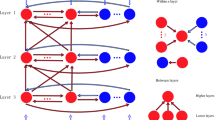Abstract
We propose a mathematical model of selective visual attention using a two-layered neural network with neurons described by the Hodgkin–Huxley equation in order to investigate part of the assumption proposed by Desimone and Duncan. The neural network consists of a layer of hippocampal formation and of visual cortex. A frequency of firing and a firing time for each neuron and also a correlation of the firing times between neurons are calculated numerically to clarify an attention state, a nonattention state, and an attention shift. We find that synchronous phenomena occur not only for the frequency but also for the firing time between the neurons in the hippocampal formation and those in a part of the visual cortex in our model. It also turns out that the attention shift is performed quickly in our model.
Similar content being viewed by others
References
Amaral DG, Witter MP (1989) The three-dimensional organization of the hippocampal formation: a review of anatomical data. Neuroscience 31:571–591
Buzsáki G, Chrobak JJ (1995) Temporal structure in spatially organized neuronal ensembles: a role for interneuronal networks. Curr Opin Neurobiol 5:504–510
Crick F (1984) Function of the thalamic reticular complex: the searchlight hypothesis. Proc Natl Acad Sci USA 81:4586–4590
Desimone R, Duncan J (1995) Neural mechanisms of selective visual attention. Annu Rev Neurosci 18:193–222
Destexhe A, Mainen ZF, Sejnowski TJ (1994) An efficient method for computing synaptic conductances based on a kinetic model of receptor binding. Neural Comput 6:14–18
Hodgkin AL, Huxley AF (1952) A quantitative description of membrane current and its application to conduction and excitation in nerve. J Physiol Lond 117:500–544
Iijima T, Witter MP, Ichikawa M, Tominaga T, Kajiwara R, Matsumoto G (1996) Entorhinal-hippocampal interactions revealed by real-time imaging. Science 272:1176–1179
Kazanovich YB, Borisyuk RM (1999) Dynamics of neural networks with a central element. Neural Netw 12:441–454
Kuramoto Y (1984) Chemical oscillations, waves, and turbulence. Springer, Berlin Heidelberg New York
Kuramoto Y, Kawasaki K, Yamada M, Kai S, Shinomoto S (1991) Pattern formation. Asakura Syoten (Japanese)
LeDoux JE (1986) The neurobiology of emotion. Cambridge University Press, pp 301–354
LeDoux JE (1987) The neurobiology of emotion. Handbook of physiology vol 5. American Physiological Society, Bethesda, MD, pp 419–459
Lopes da Silva FH, Witter MP, Boeijinga PH, Lohman AHM (1990) Anatomic organization and physiology of the limbic cortex. Physiol Rev 70:453–511
Miller R (1991) Cortico-hippocampal interplay and the representation of contexts in the brain. Springer, Berlin Heidelberg New York
Milner P (1974) A model for visual shape recognition. Psychol Rev 81:521–535
Rall W (1967) Distinguishing theoretical synaptic potentials computed for different soma-dendritic distributions of synaptic input. J Neurophys 30:1138–1168
Ritz R, Sejnowski TJ (1997) Synchronous oscillatory activity in sensory systems: new vistas on mechanisms. Curr Opin Neurobiol 7:536–546
Schmajuk N, Dicarlo J (1992) Stimulus configuration, classical conditioning, and hippocampal function. Psychol Rev 99:268–305
Singer W, Gray CM (1995) Visual feature integration and the temporal correlation hypothesis. Annu Rev Neurosci 18:555–586
Wu Z, Guo A (1999) Selective visual attention in a neurocomputational model of phase oscillators. Biol Cybern 80:205–214
Author information
Authors and Affiliations
Corresponding author
Additional information
Acknowledgements We are grateful to T. Omori for his valuable discussions and comments. K. K. was partially supported by Research Fellowships of the Japan Society for the Promotion of Science for Young Scientists. This work was partially supported by Grant-In-Aid for Scientific Research No. 13680383 from the Ministry of Education, Culture, Sports, Science and Technology (MEXT), Japan.
Rights and permissions
About this article
Cite this article
Katayama, K., Yano, M. & Horiguchi, T. Neural network model of selective visual attention using Hodgkin–Huxley equation. Biol. Cybern. 91, 315–325 (2004). https://doi.org/10.1007/s00422-004-0504-4
Received:
Accepted:
Published:
Issue Date:
DOI: https://doi.org/10.1007/s00422-004-0504-4




